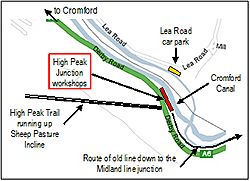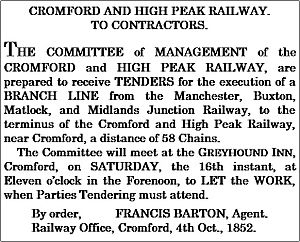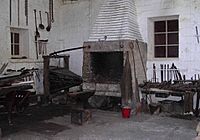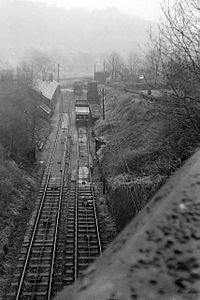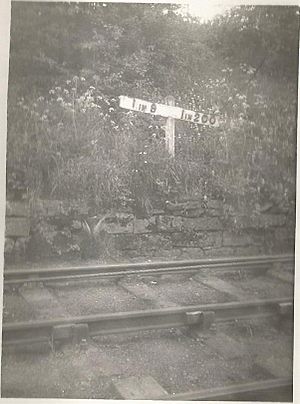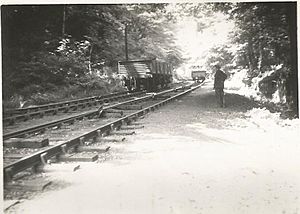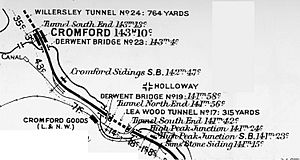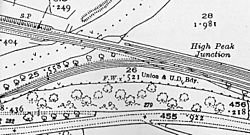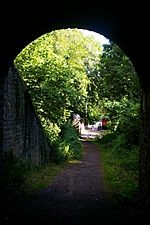High Peak Junction facts for kids
High Peak Junction, located near Cromford in Derbyshire, England, is a special place where an old railway line met a canal. This site was once home to the workshops of the Cromford and High Peak Railway (C&HPR). It's also part of the Derwent Valley Mills World Heritage Site, which was recognized in 2001.
Today, High Peak Junction is the start of the High Peak Trail. This trail is about 17 miles (27 km) long and is popular with walkers, cyclists, and horse riders. The Derwent Valley Heritage Way also passes through this spot. Many people enjoy walking along the canal towpath from here.
Contents
A Railway's Story
The Cromford and High Peak Railway was first planned as a canal. However, it was built as a railway line instead. It ended here at High Peak Junction, right next to the Cromford Canal. This is where goods were moved between canal boats and railway wagons.
The large building next to the canal, called the transit shed, is still there. From here, the railway line went past the workshops and up a very steep hill called Sheep Pasture incline.
This first part of the railway opened on May 29, 1830. It connected the Cromford Canal in the south to the Peak Forest Canal in the north. The Cromford Canal had been built earlier, in 1794. It helped connect Sir Richard Arkwright’s mills to the country's waterways.
The Workshops and Early Days
The workshops at High Peak Junction were mostly built between 1826 and 1830. This makes them some of the oldest railway workshops in the world! They were essential for maintaining the new railway line. For example, the long chains used to pull wagons up the inclines were made here.
When the railway first opened, horses pulled the wagons, except on the steep inclines. Only minerals and other goods were carried. These goods, like coal, were for local towns. Limestone was also very important. It was needed to make steel and was found in large amounts in this area.
At first, big stationary steam engines powered the inclines. In 1833, the railway got its first locomotive. This was only seven years after George Stephenson's Stockton and Darlington Railway opened. It took 30 years for steam engines to completely replace horses. Water wagons had to be carried up the inclines to supply the engines and isolated homes.
The workshops also repaired wagons and locomotives. Records show that two locomotives were built here in 1859. However, they were likely assembled here using parts bought from a foundry in Derby.
Connecting to Other Railways
For a long time, the C&HPR was only connected to canals. It was like a separate island in the railway world. About 20 years later, it finally connected to a main railway line. This new connection was with the Manchester, Buxton, Matlock and Midland Junction Railway. This happened near Cromford railway station and Whatstandwell railway station. This new connection was the *original* "High Peak Junction." The canal-side site only got this name later.
The new main line connection opened on February 21, 1853. This made the C&HPR a bit longer. More and more goods started using this new route. The Cromford Canal struggled to compete and was eventually sold to the railway company in 1852. A tunnel collapse in 1900 sealed the canal's fate as a major transport route. The canal was officially closed in 1944.
Runaway Wagons
High Peak Junction is at the bottom of the very steep Sheep Pasture incline. This incline is about 1,320 yd (0.75 mi) long and very steep. After a serious accident in 1888, a "catch pit" was built. This pit was designed to stop runaway wagons. In that accident, a wagon full of lime and another with gunpowder broke free. They sped down the incline, crashed across the site, and even jumped over the canal! Luckily, a passenger train passed minutes later. Wreckage from another runaway in the 1950s can still be seen in the catch pit today.
What's in a Name?
The name "High Peak Junction" can be a bit confusing! Today, it refers to the old workshops and canal-side area. But for most of the railway's history, "High Peak Junction" was the name of the signal box and the actual junction with the main Midland Railway line. This was about three-quarters of a mile away.
Over the years, this workshop site has had many names:
- Railwayend: This was used on old maps from the 1880s.
- Bottom of Sheep Pasture: This name described its location at the foot of the incline.
- Cromford Wharf of the C&HPR or Cromford Wharf: Some experts used these names. However, "Cromford Wharf" is now used for a different wharf near Cromford Mill.
- High Peak Wharf: This name is sometimes used to avoid confusion.
- Cromford Goods: This referred to the small goods yard and sidings near the workshops.
The Other High Peak Junction
The branch line connecting the C&HPR to the Midland main line was built in 1853. It followed the River Derwent. This was the *real* "High Peak Junction" during the railway's operating years.
At this junction, there was a signal box. It controlled the trains moving between the two railway lines. There were several tracks here for different purposes, including a siding for the C&HPR. This siding was known as High Peak Junction sidings.
The signal box, called "D22," closed in October 1967. Today, you can still see its foundations and some timber. Old telegraph poles also run from Cromford Meadows to the junction, though the wires are gone.
From Railway to Trail
The High Peak Trail
The High Peak Railway closed completely in 1967. In 1971, the old railway line from High Peak Junction workshops to Parsley Hay was bought for just £1. It was then turned into the High Peak Trail. At Parsley Hay, it connects to the Tissington Trail. The trail continues north towards Dowlow, near Buxton, for a total of 17½ miles.
The section of line from the workshops down to the original main line junction was not bought. However, it remains a public path. So, High Peak Junction, by the Cromford Canal, is the official start of the High Peak Trail. From here, the trail goes uphill through a tunnel and up Sheep Pasture incline.
High Peak Junction Today
Most of the old railway buildings are still here. These include the offices and the workshops where early locomotives were built and repaired. There's also an engine shed where the yard shunting engine used to be. In 1985, the workshops were restored and opened to the public.
Today, visitors can find an information center, a shop, and a small cafe. The shop is in what used to be an office and the oil and lamp store. The room at the end was the drivers' mess room.
Inside the workshops, many things look almost the same as when they closed. There are old tools and artifacts on display. You can even see what might be the oldest railway line in the world still in its original spot! Other interesting items include a drill, a forge, and parts of a beam engine.
About a quarter of a mile from the workshops is the canal-side Wharf Shed. This historic building once had a 10-ton crane and a weighhouse. Wagons could pass right through it. A sign still warns that engines are not allowed inside because of the wooden floors. The Wharf Shed is now a residential center for groups.
Another nearby attraction is Leawood Pump House. It was built to pump water from the River Derwent into the Cromford Canal. This helped keep the canal's water level steady. The Pumphouse started working in 1849.
You can easily get to High Peak Junction from the large public car park at Lea Bridge. A footbridge crosses the river, railway, and canal. From High Peak Junction, you can walk along the flat canal towpath or hike up the High Peak Trail.
Images for kids



